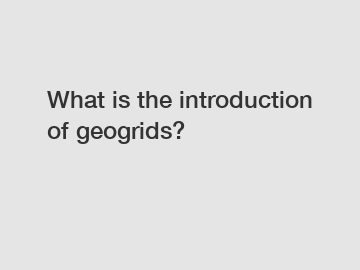What is the introduction of geogrids?
In the world of construction and civil engineering, geogrids have emerged as a revolutionary technology that has transformed the way we approach infrastructure projects. These powerful tools provide stability, reinforcement, and sustainability to various types of soil, making them an essential component of modern engineering projects.
So, what exactly are geogrids? In simplest terms, geogrids are synthetic materials that are used to reinforce soil and provide stability to structures such as retaining walls, embankments, and roads. They are typically made from polymers such as polyethylene, polypropylene, or polyester, which are resistant to chemical and biological degradation, as well as environmental factors such as UV radiation and extreme temperatures.
The primary function of geogrids is to improve the performance and longevity of soil structures by distributing loads more efficiently and reducing deformation. They work by confining soil particles and preventing them from shifting, thus creating a stronger foundation for construction projects. Geogrids are commonly used in a variety of applications, including road construction, embankments, slopes, and retaining walls, due to their ability to improve soil stability and prevent erosion.

One of the key benefits of using geogrids is their ability to reduce the amount of excavation and fill material needed for a project. By providing additional support and reinforcement to soil structures, geogrids can help reduce costs and construction time, making them a cost-effective solution for many engineering projects. Additionally, geogrids are lightweight and easy to install, making them a convenient option for both large-scale infrastructure projects and smaller residential applications.
Furthermore, geogrids are also environmentally friendly, as they can help reduce the overall carbon footprint of a construction project. By stabilizing soil structures and preventing erosion, geogrids can help conserve natural resources and reduce the need for extensive earthworks, ultimately contributing to a more sustainable and eco-friendly construction process.
In terms of their technical properties, geogrids are available in various shapes, sizes, and strengths to meet the specific requirements of different projects. They can be woven or knitted, with different aperture sizes and tensile strengths, depending on the intended use and soil conditions. Some geogrids are designed for high-load applications, such as road construction, while others are more suitable for low-impact projects, such as landscaping and erosion control.
Overall, geogrids are a versatile and innovative technology that has revolutionized the way we approach soil stabilization and reinforcement in construction projects. With their unique properties and benefits, geogrids have become an essential tool for engineers and contractors looking to create strong, durable, and sustainable structures that can withstand the test of time.
As with any technology, it is important to consult with a qualified engineer or geotechnical specialist when considering the use of geogrids in a construction project. These professionals can help determine the best type of geogrid for a specific application and ensure that it is installed correctly to achieve the desired results.
In conclusion, geogrids are an invaluable resource for modern engineering projects, offering stability, reinforcement, and sustainability to soil structures of all shapes and sizes. With their impressive technical properties and environmental benefits, geogrids have become a staple in the construction industry, helping to create durable and resilient structures that stand the test of time. So, the next time you embark on a construction project, consider the use of geogrids to ensure a strong and stable foundation for your design.
For more information, please visit concrete protection liners manufacturer, rpp geomembrane in stock, qaqc testing room.


